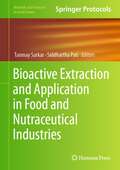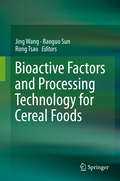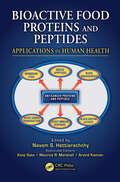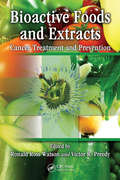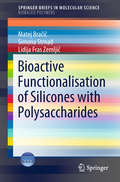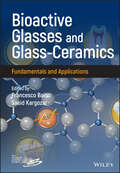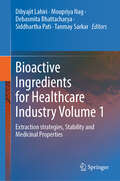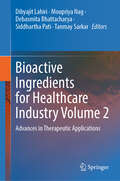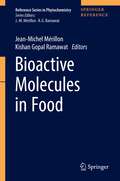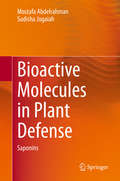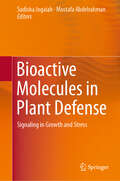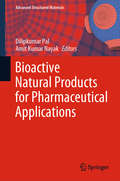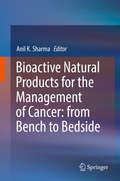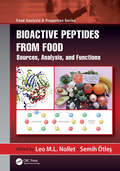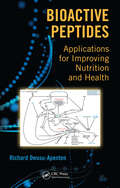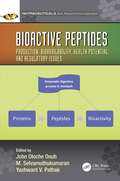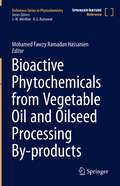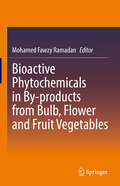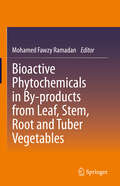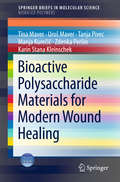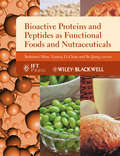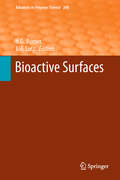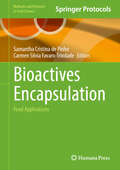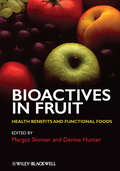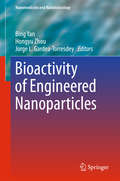- Table View
- List View
Bioactive Extraction and Application in Food and Nutraceutical Industries (Methods and Protocols in Food Science)
by Tanmay Sarkar Siddhartha PatiThis volume details state-of- the art methods on sustainable food extractions. Chapters guide readers on traditional and novel extraction techniques, as well as exploring diverse sources of bioactive compounds. Additionally, chapters provide a holistic view of the field, catering to the needs of researchers, industry professionals, and students who are interested in this rapidly evolving area. Written in the format of the Methods and Protocols in Food Science series, chapters list necessary materials and methods for readily reproducible protocols. Authoritative and cutting-edge, Bioactive Extraction and Application in Food and Nutraceutical Industries aims to be a foundation for future studies and to be a source of inspiration for new investigations in the field.
Bioactive Factors and Processing Technology for Cereal Foods
by Jing Wang Baoguo Sun RongTsao CaoThis book summarizes the reported health benefits of bioactive factors in cereal foods and their potential underlying mechanisms. Focusing on potential mechanisms that contribute to the various effects of bioactive factors on obesity, diabetes and other metabolic diseases, it helps to clarify several dilemmas and encourages further investigations in this field. Intended to promote the consumption of cereal foods or whole cereal foods to reduce the risk of chronic diseases, and to improve daily dietary nutrition in the near future, the book was mainly written for researchers and graduate students in the fields of nutrition, food science and molecular biology.
Bioactive Food Proteins and Peptides: Applications in Human Health
by Navam S. HettiarachchyMany naturally occurring compounds from foods such as rice, vegetables, fruits, and animal products possess properties that help to slow disease progression, inhibit pathophysiological mechanisms, or suppress activities of pathogenic molecules. Proteins and peptides play significant roles in such activities and are gaining importance as nutraceutic
Bioactive Foods and Extracts: Cancer Treatment and Prevention
by Victor R. Preedy Ronald Ross WatsonThough there is considerable historical and anecdotal record for the use and efficacy of the cancer preventative properties of vegetables, fruits, and herbs, modern healthcare professionals require scientific evidence and verifiable results to make defensible decisions on the benefits, risks, and value of botanicals and their extracts in the preven
Bioactive Functionalisation of Silicones with Polysaccharides (SpringerBriefs in Molecular Science)
by Matej Bračič Simona Strnad Lidija Fras ZemljičThis book covers the functionalisation of silicone surfaces with polysaccharides to improve their antimicrobial and antifouling properties, thus reducing the implant-related infections. The authors describe how silicone surfaces were chosen because silicone exhibits excellent biocompatible properties and is already being used for medical implants such as catheters, breast implants, prosthetics etc. The potential of polysaccharides such as cellulose, chitosan, hyaluronic acid, and other natural substances such as natural surfactants as coatings for silicones are also discussed, their effects are evaluated. With the aging of the population, the number of medical implants is growing and with it the number of infections associated with the use of implants.
Bioactive Glasses and Glass-Ceramics: Fundamentals and Applications
by Francesco BainoBioactive Glasses and Glass-Ceramics Fundamentals and Applications A Comprehensive and Critical Overview of Bioactive Glasses and Glass-Ceramics Bioactive glasses and glass-ceramics are a versatile class of biocompatible materials that have an astonishing impact in biomedicine. Bioactive Glasses and Glass-Ceramics: Fundamentals and Applications presents topics on the functional properties, processing, and applications of bioactive glasses and glass-ceramics. The primary use of bioactive glasses and glass-ceramics is to repair bone and dental defects; however, their full potential is yet to be fulfilled. Many of today’s achievements in regenerative medicine and soft tissue healing were unthinkable when research began. As a result, the research involving bioactive glasses and glass-ceramics is highly stimulating and continuously progresses across many different disciplines including chemistry, materials science, bioengineering, biology, and medicine. Topics relating to these disciplines and covered within the work include: Fundamentals on bioactive glasses and glass-ceramics, bioactive glasses in today’s market, and improvements and challenges for the future Scalability and other issues when taking bioactive glass from lab to industry/commercialization applications, plus clinical challenges Trending topics such as bioactive glass porous scaffolds, additive manufacturing of bioactive glasses, and nano-engineering of bioactive glasses The various bioactive glass compositions which have been developed as medical products in an expanding range of forms and applications Bioactive Glasses and Glass-Ceramics: Fundamentals and Applications serves as a comprehensive and complete reference work on bioactive glasses and glass-ceramics for research and development (R&D) materials scientists, surgeons, and physicians, and leadership at glass and medical companies. Students and professors in fields of study pertaining to the aforementioned disciplines will also derive value from the work.
Bioactive Ingredients for Healthcare Industry Volume 1: Extraction strategies, Stability and Medicinal Properties
by Moupriya Nag Dibyajit Lahiri Tanmay Sarkar Siddhartha Pati Debasmita BhattacharyaBioactive compounds obtained from natural sources has proven to possess various therapeutic potentials. Although they have proven its therapeutic efficacy for ages but a major limitation is difficulty in the extraction of single compound from its mixture. The volume 1 of the book is an important step to help the readers understand about the principles and practices associated with the extraction, stabilization and therapeutic applications of various bioactive compounds obtained from natural sources. The book provides information on various innovative techniques those are involved in the extraction processes i.e. from the conventional strategy of extraction to advanced technologies. Stability of bioactive compounds are also an important factor. Thus this book also focuses on this issue by highlighting various strategies comprising of freeze-drying, encapsulation and nanotechnology. This volume will focus on antimicrobial, antioxidant, anti-inflammatory and various other therapeutic properties of the compounds and their applications as cosmetics, nutraceuticals and pharmaceuticals. Thus this book would have a comprehensive know-how of bioactives from extraction to application.
Bioactive Ingredients for Healthcare Industry Volume 2: Advances in Therapeutic Applications
by Moupriya Nag Dibyajit Lahiri Tanmay Sarkar Siddhartha Pati Debasmita BhattacharyaThis book provides in-depth knowledge on the use of various bioactive compounds obtained from natural sources as therapeutics and healthcare solutions. The chapters emphasize on the role of bioactives in managing various types of chronic diseases and emerging healthcare challenges comprising of neurodegenerative disorders, cardiovascular diseases and various metabolic syndromes. The book presents various advanced techniques for bringing about optimization in the bioactivity, enhancement of the delivery systems and ensuring the efficiency of the therapeutics. Aimed at researchers, healthcare professionals, and industry stakeholders, Volume 2 serves as a comprehensive resource to understand the application of various types of bioactive compounds in mitigating various health associated problems.
Bioactive Molecules in Food (Reference Series in Phytochemistry)
by Kishan Gopal Ramawat Jean-Michel MérillonThis reference work provides comprehensive information about the bioactive molecules presented in our daily food and their effect on the physical and mental state of our body. Although the concept of functional food is new, the consumption of selected food to attain a specific effect existed already in ancient civilizations, namely of China and India. Consumers are now more attentive to food quality, safety and health benefits, and the food industry is led to develop processed- and packaged-food, particularly in terms of calories, quality, nutritional value and bioactive molecules. This book covers the entire range of bioactive molecules presented in daily food, such as carbohydrates, proteins, lipids, isoflavonoids, carotenoids, vitamin C, polyphenols, bioactive molecules presented in wine, beer and cider. Concepts like French paradox, Mediterranean diet, healthy diet of eating fruits and vegetables, vegan and vegetarian diet, functional foods are described with suitable case studies. Readers will also discover a very timely compilation of methods for bioactive molecules analysis. Written by highly renowned scientists of the field, this reference work appeals to a wide readership, from graduate students, scholars, researchers in the field of botany, agriculture, pharmacy, biotechnology and food industry to those involved in manufacturing, processing and marketing of value-added food products.
Bioactive Molecules in Plant Defense: Saponins
by Mostafa Abdelrahman Sudisha JogaiahThis book presents a broad perspective on saponins as important natural products with a key role in plant defense. The presence of saponins has been reported in several plant species, and many types of saponins have been found to exhibit significant antifungal activities. In addition to their role in plant defense, saponins are of increasing interest for drug research, as they are active ingredients in several traditional medicines and hold potentially valuable pharmacological properties. In this book, the authors briefly introduce readers to saponin accumulation in various plant organs, with a specific focus on their structure classification and diversity. Readers will find detailed information on the saponin structure-activity relationship and saponins’ vital role in sustainable agriculture as a chemical barrier to pathogen attack. The latest techniques for isolating, identifying, and quantifying saponins are also discussed. In the closing chapter, the authors outline the recent metabolic engineering strategies applied to improve saponin glycosides production and their potential applications in plant disease resistance.This book and the companion volume Bioactive Molecules in Plant Defense: Signaling in Growth and Stress offer vital resources for all researchers and students interested in plant pathology, mycology and sustainable agriculture.
Bioactive Molecules in Plant Defense: Signaling in Growth and Stress
by Mostafa Abdelrahman Sudisha JogaiahThis book focuses on signaling molecules in plant defense, outlining some of the most important cellular and chemical plant defense strategies during periods of stress and growth. Written by leading experts, it covers topics such as the diversity of plant-growth-promoting fungi, the gene-to-metabolite network of plant-microbe interactions, modulation of plant cellular responses to stress, and how plant nutritional deficiency affects crop production. Together with the companion volume Bioactive Molecules in Plant Defense: Saponins, this book offers an essential source of information for postgraduate students and researchers interested in plant pathology, mycology and sustainable agriculture.
Bioactive Natural Products for Pharmaceutical Applications (Advanced Structured Materials #140)
by Amit Kumar Nayak Dilipkumar PalThis book covers the recent innovations relating to various bioactive natural products (such as alkaloids, glycosides, flavonoids, anthraquinones, steroids, polysaccharides, tannins and polyphenolic compounds, volatile oils, fixed oils, fats and waxes, proteins and peptides, vitamins, marine products, camptothecin, piperines, carvacrol, gedunin, GABA, ginsenosides) and their applications in the pharmaceutical fields related to academic, research and industry.
Bioactive Natural Products for the Management of Cancer: from Bench to Bedside
by Anil K. SharmaThis book illustrates the importance of the Natural Biometabolites, which offer a rich reservoir of candidate compounds for drug discovery in the battle against cancer. Recent research and development efforts concerning anti-cancer drugs derived from natural products have led to the identification of numerous candidate molecules that inhibit cancer cell proliferation and metastasis using a variety of mechanisms. Given its scope, the book offers a valuable resource for cancer biologists and general oncologists alike, while also benefitting research professionals in Science, Nursing, Medicine, Biochemistry, Genetics and Bioscience who wish to understand the fundamentals of prognosis and prediction in tumorigenesis. Moreover, the book provides an essential platform for understanding drug resistance mechanisms and combatting the growing menace of multidrug resistance.
Bioactive Peptides from Food: Sources, Analysis, and Functions (Food Analysis & Properties)
by Leo M.L. Nollet and Semih ÖtleşA growing body of scientific evidence has revealed that many food peptides exhibit specific biological activities in addition to their established nutritional value. Bioactive peptides present in foods may help reduce the worldwide epidemic of chronic diseases that account for a great number of premature deaths annually. Bioactive peptides can be defined as isolated small fragments of proteins which provide some physiological health benefits. They act as potential modifiers reducing the risk of many chronic diseases. Bioactive Peptides from Food: Sources, Analysis, and Functions considers fundamental concepts, sources, hydrolysis, fractionation, purification, analysis, chemical synthesis, functions, and regulatory status of nutraceutical bioactive peptides. Methods of isolation of these peptides from different protein sources with their in vitro and vivo physiological effects are addressed. Divided into seven sections, this book delves into how these peptides play a major role in the development of various functional foods. Numerous bioactive peptides have been reported in recent years as naturally present or generated from food proteins of different origins like milk, eggs, soya, fish, and meat. Key Features: Includes a detailed study of the different sources of bioactive peptides Discusses the health benefits, such as antimicrobial, antiallergic, antihypertensive, antitumor, and immunomodulatory properties of peptides Explorates the state of the art analysis methods of peptides Discovers the bioinformatics of possible bioactive peptides Written by experts in their field from around the world, Bioactive Peptides from Food reveals the world of databases of peptides. It is a great resource for food scientists, technologists, chemists, nutrition researchers, producers, and processors working in the whole food science and technology field as well as those who are interested in the development of innovative functional products.
Bioactive Peptides: Applications for Improving Nutrition and Health
by Richard Owusu-ApentenChronic illnesses, injury, or infections produce a decline in muscle massleading to delayed recovery, more post-treatment complications, longer hospital stays, and higher mortality rates. Therefore, ensuring adequate lean body mass is of major concern in health care. Presenting data from human studies and trials, along with recent research findings
Bioactive Peptides: Production, Bioavailability, Health Potential, and Regulatory Issues (Nutraceuticals)
by Yashwant V. Pathak M. Selvamuthukumaran John Oloche OnuhBioactive peptides have been receiving attention recently due to their applications as health-promoting agents. Derived from food proteins and other natural sources, they exhibit various beneficial effects such as preventing diseases or modulating physiological systems once absorbed. As the market for nutraceuticals and functional foods continues to expand, consumer interest has also grown and there are many common foods that have shown an abundance of bioactive peptides, including dairy products, cereal, legumes, meat, and numerous other sources. In this newest addition to the series Nutraceuticals: Basic Research and Clinical Applications, Bioactive Peptides: Production, Bioavailability, Health Potential, and Regulatory Issues provides a comprehensive review of the current state of knowledge in the field of food protein hydrolysates and bioactive peptides, their food sources, bioavailability, production, applications, functionalities, health potentials, and regulatory issues governing their use. Features Discusses different methodologies employed for scaling up bioactive peptides commercially Provides information on optimizing the production process Explains various bioactive properties exerted by different types of bioactive peptides Explores the application of metabolomics to the study of bioactive peptides With over 20 chapters written by established subject matter experts in their field, this book provides timely information and discusses the latest developments of bioactive peptides. It will be useful for researchers, academics, and industry experts, and can serve as an excellent resource for anyone interested in enhancing their knowledge in the field of bioactive peptides.
Bioactive Phytochemicals from Vegetable Oil and Oilseed Processing By-products (Reference Series in Phytochemistry)
by Mohamed Fawzy Ramadan HassanienThis book comprehensively reviews the phytochemistry, functional properties, and health-promoting effects of bioactive compounds found in oil processing by-products, and it also explores the food and non-food applications of these by-products. Several oilseeds, vegetables, and fruits are cultivated for their oils and fats, wherein the oil extraction industry generates a huge amount of waste (meal or cake). The valorisation of this waste would be very beneficial not only from the economic and environmental perspectives, but also for the potential applications in food, cosmetics and pharmaceutical industries, in which phytochemicals derived from vegetable oil and oilseed processing by-products play an important role in, for instance, extending the shelf life of several products and providing added-value properties with their antioxidant and antimicrobial properties. In this work, expert contributors discuss about the added-value of biowaste from common and non-traditional vegetable oils and oilseeds processing, as well as fruit oils processing, and offer an extensive overview of the different bioactive compounds found in extracts from oil processing by-products and their chemical composition. The book also collects several examples in which oil processing by-products are integrated into industrial activities such as food production, livestock production and in pharmaceutical and cosmetics industries. Professionals and scholars alike interested in the recycling of agro-industrial wastes derived from vegetable oil and oilseed processing by-products will find this book a handy reference tool.
Bioactive Phytochemicals in By-products from Bulb, Flower and Fruit Vegetables
by Mohamed Fawzy RamadanThis book collates bioactive compounds from the by-products of bulb, flower and fruit vegetables, and it explores vegetable processing by-products utilization. By-products and wastes from vegetable processing have been gathering attention in the food industry due to the management of residues that pose significant disposal challenges. This book not only addresses these concerns but also underscores the potential of these by-products as sources of value-added phytochemicals, with a focus on the recovery of bioactive phytochemicals and technologically critical secondary metabolites. This book covers vegetable by-products’ economic significance, ecological implications, and their applications spanning nutrition, health, and industry. Divided into 13 chapters, the book offers an overview of the phytochemical, nutritional, biochemical and physicochemical properties of vegetable processing wastes. It discusses process by-products of diverse vegetables, including fennel, garlic, onion, artichoke, cauliflower, broccoli, bitter melon, bell pepper, chili pepper, chayote, cucumber, eggplant, green plantain banana, pumpkin and tomato. In each chapter, readers will find an economic perspective for each biowaste, the chemical analysis of the bioactive compounds, their biological and functional properties, and relevant food and non-food applications of extracts and bioactive compounds from vegetable by-products. This book, coupled with its companion volume, "Bioactive Phytochemicals in By-products from Leaf, Stem, Root, and Tuber Vegetables," serves as an indispensable resource for students, scholars, and researchers seeking to deepen their understanding of this research area. It also extends its relevance to professionals within the food industry, offering the latest insights and findings from cutting-edge research.
Bioactive Phytochemicals in By-products from Leaf, Stem, Root and Tuber Vegetables
by Mohamed Fawzy RamadanThis book offers a comprehensive overview of bioactive phytochemicals within by-products from leaf, stem, root, and tuber vegetables, and it explores the valorisation of these vegetable cultivation and processing by-products, not only as a source of valuable bioenergy but also for health purposes. Divided into 16 chapters, the book begins with an introduction to the economic significance of biowaste generated from vegetable cultivation and processing, setting the stage for subsequent chapters that cover the phytochemical, nutritional, biochemical and physicochemical properties of vegetable processing wastes and their multifaceted applications. Readers will find valuable insights into the valorisation of process by-products from diverse vegetables like cabbage, spinach, watercress, asparagus, celery, kohlrabi, beetroot, carrot, celeriac, turnip, sweet potato, potato and taro. In each chapter, readers will find an economic perspective for each biowaste, the chemical analysis of the bioactive compounds, their biological and functional properties, and relevant food and non-food applications of extracts and bioactive compounds from vegetable by-products. This book, coupled with its companion volume, " Bioactive Phytochemicals in By-products from Bulb, Flower and Fruit Vegetables" serves as an indispensable tool for students, scholars, and researchers seeking to expand their knowledge within this field in agricultural and nutritional sciences. It also extends its relevance to professionals within the food industry, offering the latest insights and findings from cutting-edge research.
Bioactive Polysaccharide Materials for Modern Wound Healing (Springerbriefs In Molecular Science: Chemistry of Foods)
by Tina Maver Uroš Maver Tanja Pivec Manja Kurečič Zdenka Peršin Karin Stana KleinschekThis is the first concise book that includes different aspects of naturally-derived components for wound healing. It presents the first exhaustive review of modern techniques in wound dressing development. With a growing, ageing population and the rapid growth of the wound-care market, the authors explore the current trend of bio-based products (active components and host materials) in this field. After a short introduction into modern solutions in wound-care and modern techniques in wound-dressing development, the authors, leaders in the field, explore natural-based components (drugs, extracts, materials etc.); safety and efficiency assessments (biocompatibility, cytotoxicity and in vitro performance etc.); and model films as a platform for the development of new wound dressings.
Bioactive Proteins and Peptides as Functional Foods and Nutraceuticals (Institute of Food Technologists Series #29)
by Eunice Li-Chan Yoshinori Mine Bo JiangBioactive Proteins and Peptides as Functional Foods and Nutraceuticals highlights recent developments of nutraceutical proteins and peptides for the promotion of human health. The book considers fundamental concepts and structure-activity relations for the major classes of nutraceutical proteins and peptides. Coverage includes functional proteins and peptides from numerous sources including: soy, Pacific hake, bovine muscle, peas, wheat, fermented milk, eggs, casein, fish collagen, bovine lactoferrin, and rice. The international panel of experts from industry and academia also reviews current applications and future opportunities within the nutraceutical proteins and peptides sector.
Bioactive Surfaces (Advances in Polymer Science #240)
by Jean-Francois Lutz Hans G. BörnerErik Wischerhoff, Nezha Badi, André Laschewsky and Jean-François Lutz Smart Polymer Surfaces: Concepts and Applications in Biosciences; S. Petersen, M. Gattermayer and M. Biesalski Hold on at the Right Spot: Bioactive Surfaces for the Design of Live-Cell Micropatterns; Julien Polleux Interfacing Cell Surface Receptors to Hybrid Nanopatterned Surfaces: A Molecular Approach for Dissecting the Adhesion Machinery; Abigail Pulsipher and Muhammad N. Yousaf Self-Assembled Monolayers as Dynamic Model Substrates for Cell Biology; D. Volodkin, A. Skirtach and H. Möhwald LbL Films as Reservoirs for Bioactive Molecules; R. Gentsch and H. G. Börner Designing Three-Dimensional Materials at the Interface to Biology; Joerg C. Tiller Antimicrobial Surfaces;
Bioactives Encapsulation: Food Applications (Methods and Protocols in Food Science)
by Samantha Cristina de Pinho Carmen Silvia Favaro-TrindadeThe purpose of this book is to give a comprehensive introduction into methods and procedures on the production of micro and nanoencapsulation systems suitable for posterior incorporation in food products. Written in the format of the Methods and Protocols in Food Science series, the chapters include an introduction to the respective topic, list necessary materials and reagents, detail well established and validated methods for readily reproducible laboratory protocols and contain notes on how to avoid or solve typical problems. Authoritative and cutting-edge, Bioactives Encapsulation: Food Applications aims to be a foundation for future studies and to be a source of inspiration for new investigations in the field.
Bioactives in Fruit: Health Benefits and Functional Foods
by Denise Hunter Margot SkinnerFor centuries we have known that fruit is important for health, but we are only just beginning to fully understand why. Bioactives in Fruit: Health Benefits and Functional Foods aims to summarise some of our current knowledge on the bioactive compounds that are associated with the health benefits of specific fruits with a strong emphasis on the validation of health benefits by human intervention trials. Reflecting the current interest in food and health, the book includes strategies to retain and enhance the bioactives in fruit through breeding, growing conditions, fruit storage, processing into ingredients and production of functional foods. To accomplish this task authors with expertise in biology, chemistry, pharmacology, food science, nutrition, medicine, and horticulture have contributed. They come from universities, government and industry funded research institutes and biotechnology and food companies in Europe, the United States, Asia and New Zealand to give the book a broad perspective. This book, describing fruit bioactives, their health benefits when consumed as a food and related topics regarding their development into fresh or processed functional foods, will be of use to postgraduate students, researchers, functional food product developers, food regulators and anyone who has curiosity about why fruit is good for you. The information contained within will provide plant breeders with new targets for the development of value-added horticultural products, and will also provide nutritionists and dieticians with a useful resource for developing strategies to assist in preventing or slowing disease onset or severity. Bioactives in Fruit: Health Benefits and Functional Foods is a major resource which will be required reading for anyone working in the fields of health and functional foods.
Bioactivity of Engineered Nanoparticles (Nanomedicine and Nanotoxicology)
by Bing Yan Hongyu Zhou Jorge L. Gardea-TorresdeyThis book brings together reviews from international experts who are exploring the biological activities of nanomaterials for medical applications or to better understand nanotoxicity. Topics include but are not limited to the following: 1) mechanistic understanding of nanostructure-bioactivity relationships; 2) the regulation of nanoparticles' bioactivity by means of chemical modification; 3) the new methodologies and standard methods used to assess nanoparticles' bioactivity; 4) the mechanisms involved in nanoparticle-biomolecule interactions and nanoparticle-cell interactions; and 5) biomedical applications of nanotechnology. The book will be a valuable resource for a broad readership in various subfields of chemical science, engineering, biology, environment, and medicine.
